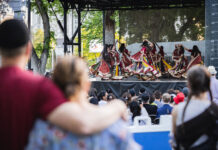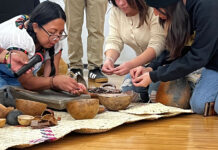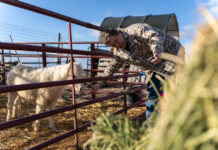The Great Salt Lake Collaborative is a group of news, education and media organizations – including The Globe and student journalists at Salt Lake Community College – that have come together to better inform and engage the public about the crisis facing the Great Salt Lake.

The Great Salt Lake Collaborative hosted an event about the history of the largest saline lake in the Western hemisphere on Sept. 28.
Alongside historian Gregory Smoak and anthropologist Daron Duke, Darren Parry, former chair of the Northwestern Shoshone Nation, informed a crowd of 35 about the importance of the Great Salt Lake – both historically and currently.
Parry said the lake is so central to his people that their creation story comes from the lake — and his nation is still fighting for the lake’s livelihood today.
According to Parry, the Northwestern Shoshone Nation is restoring Boa Ogoi (Bear River) to put “millions of gallons” of water back into the river, which should eventually enter the lake.
“These are water rights that we’re not going to use. We’re going to clean up some of the waterways and put fresh clean water back into the Bear River,” Parry said.
However, Parry said he learned the river restoration project might not help the lake as intended after he attended a lecture where he spoke about the nation’s plans.
“An old farmer sitting to the side of me just chuckled … he said, ‘That water will never get to the lake,’” Parry said. “It’ll get used before it gets to the lake.”
Current legislation enables water rights holders downstream to use the water donated by the Northwestern Shoshone Nation. This will happen when water rights are donated to the lake until there is a way to regulate water use.
The So-so-goi’s (Shoshone) connection to their land influenced different resource extraction techniques compared to the settler-colonists that arrived in the 1800s.
“When the environment is what takes care of you every day, then you tread lightly. You treat it differently,” Parry said.
He said his ancestors lived a life that was “beautiful every day” pre-colonialism. Their use of water in this area was different than the Utah government’s current water resource practices.
“As they did that hunter-gathering style, they didn’t create irrigation systems,” Parry said. “They just went to where the water source was and forged a life out of the surrounding areas.”
The lake wasn’t just a source of water and food for the So-so-goi (Shoshone) as they moved around. The lake’s water was also used medicinally because of the minerals in the water.
“My grandmother always talked about the healing properties of Great Salt Lake specifically,” Parry said.
He said plants surrounding the lake also provide healing medicine. He still has the detailed diary his grandmother created about these healing plants.
“I grew up learning about [this] … If I had a stomachache, I could make a tea out of [rabbitbrush] and cure myself,” Parry said. “They knew all of that, and it must’ve taken a long, long time for that knowledge to be disseminated.”






